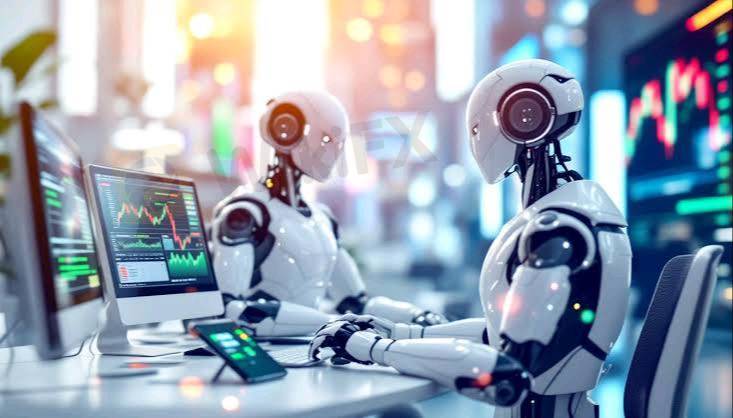
2025-04-01 10:11
IndustryHow Al ldentifies Forex MarketPattern Recurrence
#AITradingAffectsForex
The forex market is incredibly complex, and AI is increasingly used to analyze its vast amounts of data and identify recurring patterns. Here's a breakdown of how AI achieves this:
Key AI Techniques:
* Machine Learning:
* AI algorithms, particularly those within machine learning, are trained on extensive historical forex data. This allows them to "learn" the relationships between various market factors and price movements.
* These algorithms can identify patterns that are too subtle or complex for human traders to detect.
* Neural Networks:
* These are designed to mimic the human brain's ability to recognize patterns. They are particularly effective at analyzing the non-linear relationships that are common in forex markets.
* Neural networks can identify recurring patterns like:
* Price consolidations
* Breakouts
* Reversal formations
* Deep Learning:
* A subset of machine learning, deep learning uses multiple layers of neural networks to analyze even more complex data.
* This allows AI to identify highly intricate patterns and make more accurate predictions.
* Time Series Analysis:
* Forex data is essentially time series data, meaning it's a sequence of data points indexed in time order.
* AI uses time series analysis techniques to identify trends, seasonality, and other patterns within this data.
How AI Identifies Patterns:
* Data Collection and Preprocessing:
* AI systems gather data from various sources, including historical price data, economic indicators, and news feeds.
* This data is then cleaned and preprocessed to ensure its accuracy and consistency.
* Pattern Recognition:
* AI algorithms analyze the processed data to identify recurring patterns and trends.
* This involves looking for specific chart formations, price movements, and correlations between different currency pairs.
* Predictive Modeling:
* Based on the identified patterns, AI systems build predictive models to forecast future price movements.
* These models can help traders make informed decisions about when to buy or sell currencies.
* Risk Management:
* AI can also be used to assess and manage risk. By analyzing market volatility and other factors, AI systems can help traders set appropriate stop-loss orders and adjust their position sizes.
In essence:
AI excels at processing massive amounts of data, finding hidden patterns, and making predictions that can give forex traders a significant advantage. However, it's important to remember that the forex market is inherently unpredictable, and no AI system can guarantee profits.
Like 0
nick5220
Trader
Hot content
Industry
Event-A comment a day,Keep rewards worthy up to$27
Industry
Nigeria Event Giveaway-Win₦5000 Mobilephone Credit
Industry
Nigeria Event Giveaway-Win ₦2500 MobilePhoneCredit
Industry
South Africa Event-Come&Win 240ZAR Phone Credit
Industry
Nigeria Event-Discuss Forex&Win2500NGN PhoneCredit
Industry
[Nigeria Event]Discuss&win 2500 Naira Phone Credit
Forum category

Platform

Exhibition

Agent

Recruitment

EA

Industry

Market

Index
How Al ldentifies Forex MarketPattern Recurrence
 United States | 2025-04-01 10:11
United States | 2025-04-01 10:11#AITradingAffectsForex
The forex market is incredibly complex, and AI is increasingly used to analyze its vast amounts of data and identify recurring patterns. Here's a breakdown of how AI achieves this:
Key AI Techniques:
* Machine Learning:
* AI algorithms, particularly those within machine learning, are trained on extensive historical forex data. This allows them to "learn" the relationships between various market factors and price movements.
* These algorithms can identify patterns that are too subtle or complex for human traders to detect.
* Neural Networks:
* These are designed to mimic the human brain's ability to recognize patterns. They are particularly effective at analyzing the non-linear relationships that are common in forex markets.
* Neural networks can identify recurring patterns like:
* Price consolidations
* Breakouts
* Reversal formations
* Deep Learning:
* A subset of machine learning, deep learning uses multiple layers of neural networks to analyze even more complex data.
* This allows AI to identify highly intricate patterns and make more accurate predictions.
* Time Series Analysis:
* Forex data is essentially time series data, meaning it's a sequence of data points indexed in time order.
* AI uses time series analysis techniques to identify trends, seasonality, and other patterns within this data.
How AI Identifies Patterns:
* Data Collection and Preprocessing:
* AI systems gather data from various sources, including historical price data, economic indicators, and news feeds.
* This data is then cleaned and preprocessed to ensure its accuracy and consistency.
* Pattern Recognition:
* AI algorithms analyze the processed data to identify recurring patterns and trends.
* This involves looking for specific chart formations, price movements, and correlations between different currency pairs.
* Predictive Modeling:
* Based on the identified patterns, AI systems build predictive models to forecast future price movements.
* These models can help traders make informed decisions about when to buy or sell currencies.
* Risk Management:
* AI can also be used to assess and manage risk. By analyzing market volatility and other factors, AI systems can help traders set appropriate stop-loss orders and adjust their position sizes.
In essence:
AI excels at processing massive amounts of data, finding hidden patterns, and making predictions that can give forex traders a significant advantage. However, it's important to remember that the forex market is inherently unpredictable, and no AI system can guarantee profits.
Like 0
I want to comment, too
Submit
0Comments

There is no comment yet. Make the first one.

Submit
There is no comment yet. Make the first one.